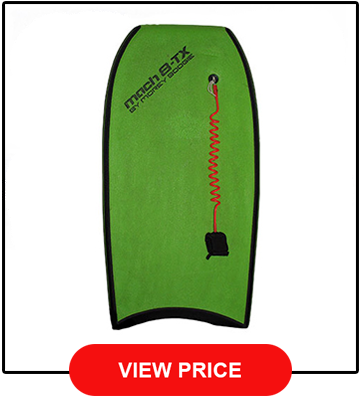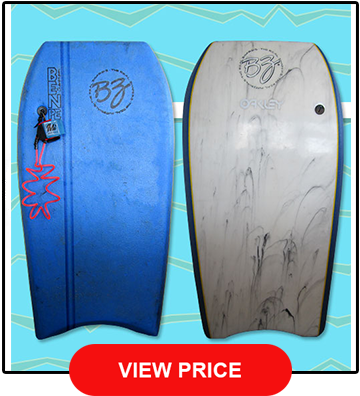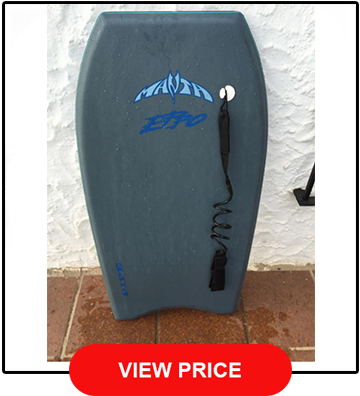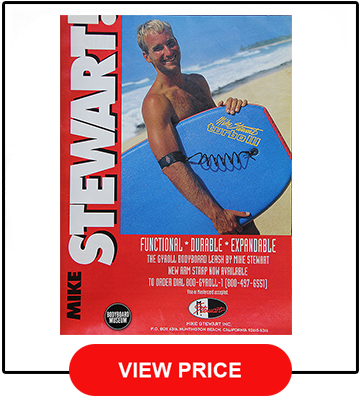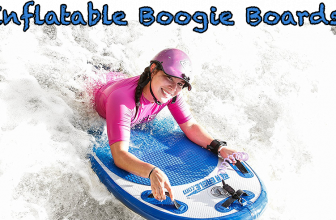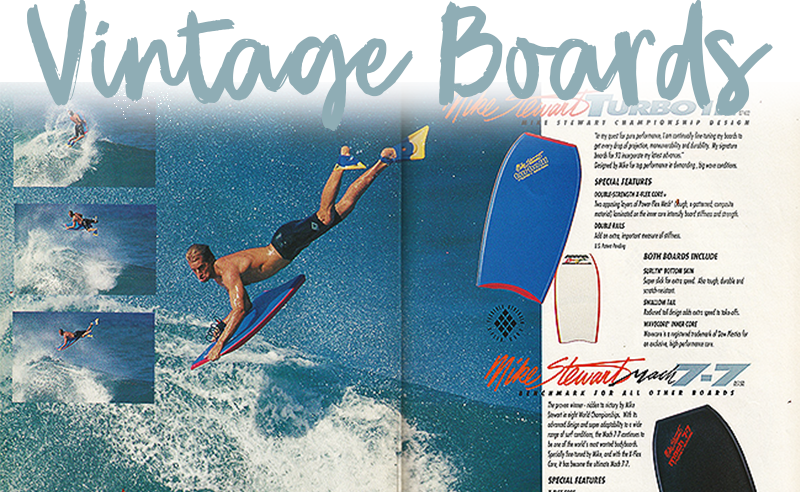
For over four decades, these old vintage bodyboards have been gracing the ocean waves in their fun, unique, and compact style.
More...
Invented by Tom Morey in 1971, the original bodyboards were oddly shaped and cheaply made.
As the years went by, bodyboards went from “just here to have some fun” kind of products to high quality and high performance boards that one could use to shred some pretty solid waves.
Now looking back on the past years, it’s cool to see how these boards were a reflection of the era in color, style, shape, and utility.
If you’re interested in getting into the world of bodyboard collecting, or simply just want to get out and ride some historical boards, we’ve created a list of some our favorite vintage bodyboards that we know you will get a kick out of!
The Top 17
#1 Pick - Mike Stewart Mach 7-7
The Legendary Mach 7-7 boogie made in the early 80s went through a huge transitional period up until it completely evolved in 1991 through the help of 9-time world champion bodyboarder Mike Stewart.
He helped to design a board that could handle waves of up to 12 feet tall with an incredible amount of power and speed.
From the sort-of unpleasant yellow top original version to a sleek black deck, and a semi-flexible body to the improved X-Flex core reinforcement to create a stronger board overall, Mike Stewart truly reinvented a classic bodyboard.
#2 - MOREY MACH 8-TX
In the year 1992, the Morey Mach 8-TX rode a high-flying wave into the bodyboarding community in a process they liked to call “air lubrication”.
Marketed as the “Anatomy of Speed”, the Mach 8-TX known for the dimples across the bottom layer that were made to allow the board to hover over tiny air bubbles atop a wave.
This inspiration for this idea was drawn submarine designs and was said to deliver better acceleration and more speed.
This board was definitely the future of the past. We’re still not sure whether or not these actually did what they were meant to do, though it was certainly a cool concept.
#3 - BZ Ben (Severson)
Born out of the mind of bodyboarding pioneer and world champion Ben Severson, the 1990 BZ Ben bodyboard was easily one of the most high performance boards of the era.
Known for the smooth chines, crisp, stylish template, and stiff Arcel core, it was truly the front-runner in the lineup of BZ boards.
The board came without channels (grooves running down the rails of the board) so the rider could easily perform sliding tricks.
To make them even more special, only 999 of these bad boys were given a 3-digit seal of excellence by Ben, the man himself, making these an awesome collectors item.
#4 - MANTA EPPO
Michael Eppo Eppulsten, the man that trademarked the backflip at the World Title at Pipeline in ‘93.
Easily one of the most explosive bodyboarders in Australia during the 1990s, Manta worked with Eppo to come out with a signature board.
With a 42” inch build, industry standard polypropylene, and channels for control this board was crazy fast.
They’re surely not the prettiest on the list, but they are still a great addition to any collection.
#5 - Mike Stewart Turbo III
A much less popular board than the OG turbo from Mike Stewart, and somewhat wrapped up in mystique, the Turbo III took the Turbo line to the next level with its polyethylene X-Flex core and Surlyn bottom.
A layer of power flex mesh was sandwiched in between the core and bottom layer to deliver the perfect mix of strength and flex. Mike Stewart was at it again, creating super technical boards for all bodyboard shredders alike.
The Turbo boards were pioneering products of the bodyboarding community.
#6 - BZ BARBA

Back in the 90s, Chad Barba was the ocean madman of the Newport wedge, hitting some of the gnarliest waves on the planet.
Just as Barba ran away from the spotlight after the boogieboarding scene became too much, his boards did as well.
Easily one of the most obscure and mysterious boards on this list, the BZ Barba was designed similarly to the Ben T-10 boards and offers the same power for charging monster swells like the legend himself. If you can find one of these out there, we applaud you.
#7 - Wave Rebel Kainoa McGee
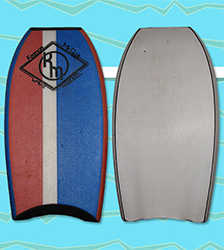
Wave Rebel, a now renowned brand that made their big debut in the early 80s when they lured a lot of the Morey Boogie boarders to their side, released a number of boards over a few decades as signature models for the riders on their team.
Kainoa McGee, now one of Hawaii’s premiere watermen, came out with a sweet little board back in 1992. Some of the features included an ultra high-density Volextra foam bottom, slick 50/50 rails, dual channel for grip, and ultra dense Volara lower rails for strength.
#8 - Rheopaipo Ben Holland
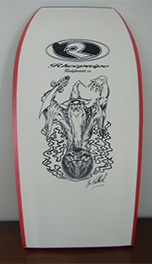
Rheopaipo boards started coming onto the scene after their popularity expanded from the Australian Central Coast in the 1990’s. Ben Holland really made a name for them as he one of Australia’s top riders, as well as paved the way for gymnastics bodyboarding with his wild flips and turns.
These boards are very rare nowadays. With their strong flex build, elbow leash design, and classic wizard logo, these boards are a serious find for any bodyboarding enthusiast.
#9 - WAVE REBEL GT
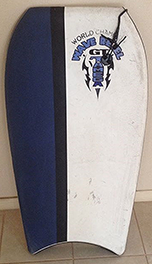
To give you an idea of just how much of an impact Guillherme Tamega had on the world of bodyboarding, they are still manufacturing these GT boards today. With a lineup of boards that spans back to the early 1990’s, the most popular was easily the 2000 pro model.
With a strong Arcel Core, Dura-deck and rails, and a sleek bat tail, these boards were meant to help you sail fast like Tamega. You can still catch these sorts of boards all over the Internet today in different styles and designs.
#10 - MIKE STEWART PRO COMP I / II
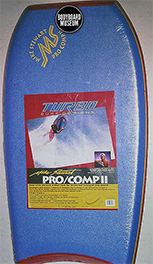
The Mike Stewart Pro Comp boards first came onto the scene in 1990. Though the two versions of the boards look fairly similar, the inner workings are what set the two apart. A ton of boards at the time had stiff polystyrene bottoms, which Mike was not too fond of. They decided to throw a softer, yet still durable, Sturlyn material on the bottom that set the Mike Stewart board about from others in the Turbo line.
A year later, they came out with the Pro Comp II. Though the board was still a dark navy blue with almost identical features, the main differences were the diagonal facing logo change and the X-Flex core addition for extra strength. These are classic boards from one of the most recognizable rides in bodyboard history.
#11 - Morey Mach SCS

The Morey Boogie Mach SCS was easily one of the most revolutionary boards of the 1990s. With a super futuristic terminator-style chrome aesthetic, this board was a kind all its own. Like the Mach 8-TX, Morey added dimples to the underside of this board, though this time, in a slimmer fishtail pattern.
The board was also the first of its kind, as it had a contoured bottom and finger grips on the front of the board. The SCS stood for “step channel system” and essentially made this board a heck of a lot easier to perform spin tricks on.
#12 - Manta Roach
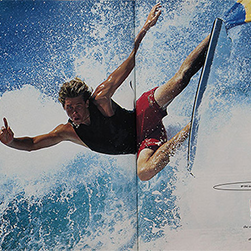
Paul Roach was known for his super aggressive drop knee style riding back in the 1990s. The Manta team designed a board that would help to accommodate that sort of style.
With an ultra strong core, this board was made to work with skate style moves of drop knee riders. You’d be lucky to find one of these things sailing around the Internet nowadays, as Roach has teamed up with DK and Cartel to make newer, more hi-tech boards.
#13 - Custom X Fred Booth
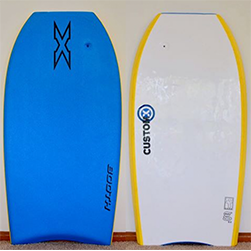
Fred Booth was one of Custom X’s biggest bodyboard riders throughout the 90s. His style took advantage of both prone and dropknee riding, while he truly focused on free surf rather than hitting tons of contests.
Easily spotted by the giant “X” on the nose of the boards with “Booth” by the tail, the 50 / 50 Fred Booth boards have been in production for over 20 years. Originally designed in a bright Orange with a slick bat tail back, they have now been completely revamped with Polypro.
#14 - MANTA MIRAGE
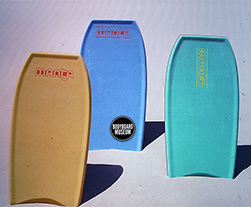
The Manta Mirage, not to be confused with the Mirage Comp, was actually a pretty incredible board that, in a way, outshined many Manta boards.
With the standard Polypro design and channels, the stand out part of this board was the raised edges that made it super easy to grip. The unique vinyl deck was also pretty sweet at the time, though a little kooky in retrospect. You can still find mirage boards all over the Internet in different colors and styles.
#15 - Morey Skipp SS
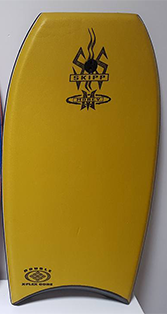
Back in the 90s, Spencer Skipper came onto the scene much like Mike Stewart, with a super laid back attitude and flow when it came to riding. With the classic performance template, the 1997 Morey Skipp SS offered the same features as other SS boards with a double X-flex mesh for ultimate strength and flexibility.
The shiny blue bottom with the dark yellow contrast on top gave an ode to the classic SS boards as well. Now that Skipper has made other boards with various bodyboarding companies, the OG Morey Skipp boards can be pretty difficult to find.
#16 - Morey Steve MacKenzie Bullet

Macca was one of the earlier bodyboarders that paved the way for many big riders today. He was a huge knee rider until he strained his tendons and had to go back to shredding prone.
His signature Bullet design that came about in the early 90s banked off of the dimples on the underside of the board that some of the Morey boards were known for. The simple blue deck, white and black rails, and silver bottom, gave off that turn of the 80s-style just as Macca did.
#17 - Manta Wingnut
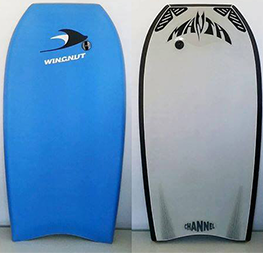
Adam Smith, or better known to the bodyboarding community as Wingnut, bust onto the scene with the Manta team at only 10 years old! His signature board had some very recognizable features. The most obvious is the signature nosepiece that was on all Wingnut boards.
If that’s not enough the ocean blue top, fish tail back, and stiff design for ripping hard, were what made this board an all around winner. There are many kinds of Manta Wingnut boards all around the world in different designs and colors. The original design was so legendary, even Quigley is remaking it.
Where To Find Old Vintage Bodyboards
Now that you’ve felt an incredible rush of nostalgia and have the burning desire to boogie on down to the water in vintage style, you might be asking yourself, “Why did I ever end up selling my beloved bodyboard, and how do I get it back?”
Luckily, there are tons of places online that can help you relive those days out in the water:
Ebay
People from all over the world are on here trying to get rid of their boards or cash in their high-end collections. Just be aware of fakes or people who are misinformed.
Craigslist
Craigslist might be awesome if you’re a So Cal local, though if you’re trying to get a boogie board from the guy down the street in a rural Oklahoma town, we wish you the best. Though the pickings might be sparse on Craigslist, you can go down and see the board for yourself before picking it up and hopefully get more of a backstory to verify the legitimacy of the board.
Vintage Bodyboard Collectors / Collective:
https://www.facebook.com/groups/545274492161425/
With a super close community of only around 1,500 people, this is an awesome spot to swap knowledge on where you might be able to find the board you’ve been looking for
Vintage Body Board Collectors – BUY SWAP SELL
https://www.facebook.com/groups/1607530482885989/
This group is about 13,000 people smaller than the above group, but definitely worth a shot!
Garage Sales
Sort of like Craigslist, you’ll have to be lucky to score a vintage bodyboard at one of these. Though, chances are if you live near a beach, some old guy or gal will be cleaning house and not even know what they’re giving away.
Pawn Shops
These are always worth a shot. Just pray that the guy doesn’t know what he’s selling you. Hopefully he thinks it’s a Wham-O board!
Used Sporting Goods Stores
Play-It-Again Sports is an excellent example of a used sporting goods store that gets a ton of used gear in from kids that have simply outgrown their stuff or don’t use it anymore. It’s more than likely that someone has come in to drop off one of their old Morey boards without even contemplating the value.
Frequently Asked Questions
How did bodyboarding come about?
Bodyboarding will turn 50 years old in 2021. The all-American surfer and musician, Tom Morey, invented it back in 1971. He originally cut out a big piece of polyethylene foam and covered it in Newspaper. Surely he couldn’t have guessed that by the late 1970s, over 80,000 of his special boards had been sold worldwide.
How do different types of core materials work on these bodyboards?
The two prominent types of materials that you’ll see on vintage bodyboards are polyethylene and polypropylene. These types of foams have been used since these boards came about in the early 70s. Polyethylene is very flexible, is great for speed, and is just a bit heavier than Polypro. Polypro is much stiffer than Polyethylene, though much lighter. Some might complain that it gets a bit too stiff in cold waters though.
What are the different pieces of a bodyboard that I should know about?
The main parts of the board you’ll want to know about are the tail, rails, chines, wide point, and rocker.
Different tail shapes can have different effects on your riding. If you’re tail is super wide, it’s going to be a bit faster and more stable. If the tail is narrower, it is going to be easier to maneuver the board. The crescent tails are the most popular and come in clipped and full designs. The clipped have both hold and speed and are very well rounded, while the full crescents are more maneuverable and stable for drop knee riders. Mike Stewart came about with the bat tail design in the 90s. These tails give the rider increased contact with the face of the wave and are best for the tricksters riding prone.
Rails are the sides or edges of the board that help you carve through the waves. They will typically either come in 50/50 or 60/40 which both offer a pretty solid balance. The thing you’ll want to watch out for is how steep the edges are. Steeper angles will give you more control while taking away your drive, while narrow angles will let you drive faster while making it difficult to turn because of the decreased vacuum sensation.
The chine is essentially the top part around the deck that wraps around to meet the rails. The chines are the second numbers in the 50/50 and 60/40 ratios. The 40% chine will offer a little more control, while the 50% chine offers more speed and maneuverability.
When somebody mentions a wide point on the board, it literally means the widest point of the board from one rail to the other. If you have a very wide board, it will be a lot more buoyant. On the other hand, a narrower board helps riders to turn sharp into the pocket. Most of the later vintage boards became narrower as time went on.
Lastly, the rocker is the curve of your board. You’ll want to get a board that is relatively flat to start off with, as the rocker will inevitably develop over time as you continue to ride and expose your board to the elements. A little bit of rocker makes a board easier to maneuver, while a flatter board increases speed.
How can I best take care of my vintage bodyboard to prolong its life?
For starters, follow the golden rule: NEVER leave your board sitting in the sun. This will mess with the rocker that we just mentioned and deform your board. As you would do with a surfboard, be sure to clean and rinse your board with freshwater as soon as you get done with your riding session. When you store it, put it in a cool dark place and do not lean anything on it or put anything on top of it. Lastly, though it might seem obvious, don’t go riding your board like a skim board. Unless you want to completely destroy your rocker and be labeled the kook of the beach, we don’t recommend it.
>> See Our #1 Recommended Vintage Bodyboard - Click Here <<


